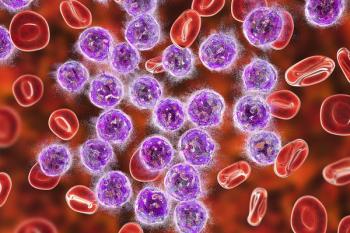
Rapid Generation of Virus-Specific T Cells Helps Fight Off Infection in Immunocompromised Patients
Rapidly generated virus-specific T cells (VSTs) were safe and effective against five infections that commonly affect immunocompromised patients after marrow or stem cell transplantation, according to a new small study.
Rapidly generated virus-specific T cells (VSTs) were safe and effective against five infections that commonly affect immunocompromised patients after marrow or stem cell transplantation, according to a new small study. The approach could help many patients with various types of leukemia, among many other conditions.
Though previous research has shown promise with this approach, “broader application of VSTs is limited by the restricted number of viruses that have been targeted and the lengthy, complex, and costly methodology required for production,” wrote study authors led by Anastasia Papadopoulou, PhD, of Baylor College of Medicine in Houston. The new work, published in Science Translational Medicine, aimed to reduce the time and expense to create cells that target a number of viruses.
The researchers used direct stimulation of peripheral blood mononuclear cells (PMBCs) from allogeneic stem cell donors, and were able to generate a 13-fold expansion of the cells within 9 to 11 days, a drastic improvement over other methods. The cells were made to recognize immunogenic antigens from five viruses: Epstein-Barr virus, adenovirus, cytomegalovirus, BK virus, and human herpesvirus 6.
To test the virus-specific T cells’ safety, they administered them to 11 hematopoietic stem cell transplant patients; these patients had a number of underlying reasons for the transplant, including acute lymphoblastic leukemia, non-Hodgkin lymphoma, and others. Eight of the patients received the VSTs as a treatment for established viruses, while the other three received them as prophylactic treatment.
The treatment was generally safe and well tolerated. One patient developed de novo graft-vs-host disease of the skin, two patients developed transplant-associated microangiopathy, though the authors wrote this was unlikely to be related to the VST infusion. No patient developed any elevation of plasma cytokines after infusion.
The three patients who received the VSTs prophylactically remained completely viral infection-free for more than three months afterward. Among the other eight patients, who had a total of 18 different viral infections/reactivations, there was a 94% response rate to the VSTs; there were 15 complete responses and two partial responses. “In all cases, viral clearance was associated with an increase in the frequency of T cells directed against the infecting virus(es),” the authors wrote.
They also noted that other potential methods for generating VSTs, including Streptamer isolation or IFN-γ capture from peripheral blood, might end up proving even more rapid. “The ultimate value of multivirus-specific T cell lines will depend both on their antiviral potency and safety and on the speed with which they can be made available,” they wrote. Whatever approach wins out, the use of VSTs may indeed prove to be an effective way to battle infections in immunocompromised patients.
Newsletter
Stay up to date on recent advances in the multidisciplinary approach to cancer.
































































































